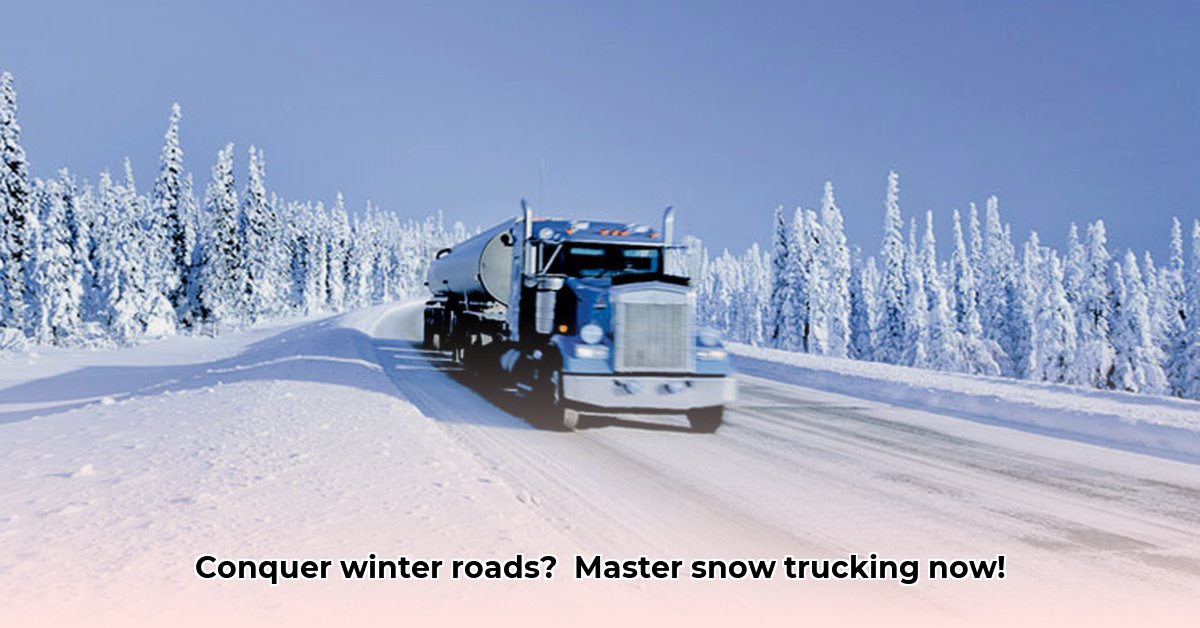
Driving Tractor Trailers in Snow: Mastering Winter's Challenges
Conquering winter's icy grip while driving a big rig demands specialized skills. This guide equips you to navigate the unique challenges of snowy conditions, from preparation to emergency response. Remember, arriving late is always preferable to not arriving at all. For additional snow removal equipment information, see this helpful resource.
Pre-Trip Preparations: Setting the Stage for a Safe Journey
Before starting your engine, a thorough pre-trip check is crucial. Consider this your pre-flight checklist for your 18-wheeler. Failing to do so increases your risk of accidents significantly. How many winter trucking accidents are caused by inadequate pre-trip checks? The number is alarmingly high.
- Tire Check: Inspect tire inflation and condition. Winter tires or chains are highly recommended in snowy regions. Under-inflated tires dramatically increase stopping distances in snow.
- Load Security: Ensure cargo is properly secured and evenly distributed to maintain balance and stability on slippery surfaces. Poorly secured cargo is a common cause of rollovers.
- Emergency Kit: Pack a comprehensive kit including: warm blankets, extra clothing, high-energy food, water, a shovel, jumper cables, a first-aid kit, gloves, hat, scarf, a flashlight with extra batteries, road flares or reflective triangles, a fully charged cell phone and portable charger, sand or kitty litter for traction, and maps (for GPS backup).
- Route Planning: Check weather forecasts meticulously; avoid known trouble spots. Plan alternate routes to circumvent potentially hazardous areas. Failing to plan your route increases the likelihood of encountering hazardous driving conditions.
- Risk Assessment: Utilize a risk assessment matrix (see below) to identify potential hazards and implement mitigation strategies. Proactive risk assessment is a cornerstone of safe winter driving.
| Hazard | Likelihood | Severity | Mitigation Strategy |
|---|---|---|---|
| Loss of Traction | Very High | Very High | Reduce speed, increase following distance, use winter tires/chains, cautious acceleration/braking. |
| Jake Brake Malfunction | Moderate | High | Regular maintenance, use engine braking instead on icy patches. |
| Trailer Brake Malfunction | Moderate | High | Regular maintenance, pre-trip inspections; address frozen components promptly. |
| Poor Visibility | Moderate | Moderate | Keep lights and windows clean; use fog lights when necessary. |
| Equipment Failure (General) | Moderate | Moderate | Regular maintenance, pre-trip inspections, a well-stocked emergency kit. |
Defensive Driving Techniques: Smooth Sailing in Snowy Conditions
Driving a tractor-trailer in snow requires a completely different approach. Aggressive driving is dangerous; gentle maneuvers are key.
- Speed Control: Observe lower speed limits; braking distances are significantly longer in snowy conditions. Increase following distances to three or four times the normal distance.
- Cornering: Reduce speed well before turns; avoid sudden steering movements. Slow, controlled movements are crucial. Sudden steering inputs are a major contributor to jackknifes.
- Anticipation: Constantly scan the road and anticipate the actions of other drivers, who may not be as prepared for winter driving.
Mastering Your Truck Systems: Using Technology Wisely
Your truck has features aiding control in challenging situations; using them correctly is vital.
- Engine Braking and Retarders: Use these cautiously on icy surfaces; aggressive use can cause wheel lockup and jackknifing.
- Traction Control: While helpful, traction control is not a substitute for cautious driving.
- Consult Your Manual: Refer to your truck's owner's manual for specific instructions on system operation in winter conditions.
Emergency Procedures: Handling the Unexpected
Despite your best efforts, unexpected situations can happen. Being prepared is key.
- Skidding: Ease off the accelerator; steer gently in the desired direction. Avoid harsh movements.
- Jackknifing: Ease off the accelerator; steer and brake gently. Call for assistance immediately.
- Getting Stuck: Call roadside assistance; use your shovel and traction aids (sand/kitty litter) to try and free yourself. If the situation is dangerous, remain in the truck and await assistance.
Legal Considerations and Regulations
Regional and state regulations regarding winter driving vary. Check local regulations before departure. Prioritize safety over schedules; delay your trip if conditions are unsafe. Ignoring regulations can lead to severe penalties.